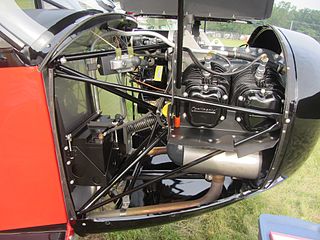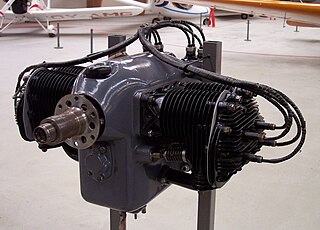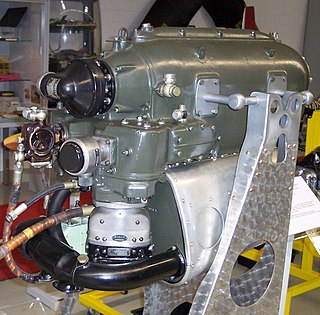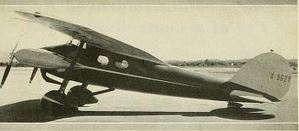
The de Havilland Gipsy Major or Gipsy IIIA is a four-cylinder, air-cooled, inverted inline engine used in a variety of light aircraft produced in the 1930s, including the famous Tiger Moth biplane. Many Gipsy Major engines still power vintage aircraft types.

The Continental C90 and O-200 are a family of air-cooled, horizontally opposed, four-cylinder, direct-drive aircraft engines of 201 in³ displacement, producing between 90 and 100 horsepower.

The Continental O-170 engine is the collective military designation for a family of small aircraft engines, known under the company designation of A50, A65, A75 and A80. The line was designed and built by Continental Motors commencing in the 1940s. It was employed as the powerplant for civil and military light aircraft.

The Lycoming O-540 is a family of air-cooled six-cylinder, horizontally opposed fixed-wing aircraft and helicopter engines of 541.5 cubic inch displacement, manufactured by Lycoming Engines. The engine is a six-cylinder version of the four-cylinder Lycoming O-360.

The Continental O-190 is a series of engines made by Continental Motors beginning in the 1940s. Of flat-four configuration, the engines produced 75 hp (56 kW) or 85 hp (63 kW) respectively.

The Aeronca Model 50 Chief was an American light plane of the late 1930s. Consumer demand for more comfort, longer range and better instrumentation resulted in its development in 1938, powered by a 50-horsepower (37-kilowatt) Continental, Franklin or Lycoming engine. A 65-horsepower (48-kilowatt) Continental engine powered the Model 65 Super Chief, which was also built in a flight trainer version, the Model TC-65 Defender, with its rear seat positioned nine inches higher than the front for better visibility.

The E-113 was a small flat-twin piston engine developed by Aeronca for use in some of their light aircraft. It was an overhead valve development of the flathead configuration E-107.

The Franklin O-150 was an American air-cooled aircraft engine of the late 1930s. The engine was of four-cylinder, horizontally-opposed layout and displaced 150 cu in (2 L). The power output was nominally 40 hp (30 kW).
The Franklin O-175 was an American air-cooled aircraft engine of the 1940s. The engine was of horizontally-opposed four-cylinder and displaced 175 cu in (2.9 L). The power output was nominally 80 hp (60 kW). A later variant was designated O-180, despite sharing the same displacement.

The Franklin O-200 was an American air-cooled aircraft engine of the early 1940s. The engine was of four-cylinder, horizontally-opposed layout and displaced 200 cu in (3 L). The power output ranged between 65 hp (48 kW) and 100 hp (75 kW) depending on variant. The O-200-5 (4ACG-199) featured a geared propeller drive.

The Walter Atom is an air-cooled horizontal two-cylinder engine used on light aircraft. The Atom is a Czechoslovakian engine first produced in 1934.

The Continental A40 engine is a carbureted four-cylinder, horizontally opposed, air-cooled aircraft engine that was developed especially for use in light aircraft by Continental Motors. It was produced between 1931 and 1941.

The Armstrong Siddeley Ounce was a small two-cylinder aero engine developed by Armstrong Siddeley in 1920. The engine was originally conceived as a test piece but ran very well and was put into production for early ultralight aircraft and use in target drones. The Ounce used two cylinders from the preceding Jaguar I radial engine.

The Lycoming O-145 is a family of small, low-horsepower, four-cylinder, air-cooled engines. It was Lycoming Engines' first horizontally opposed aircraft engine and was produced from 1938 until the late 1940s. The family includes the reduction-geared GO-145. The O-145 received its Approved Type Certificate on 13 Jun 1938.

The Lycoming IO-390 engine is a horizontally opposed, four-cylinder aircraft engine, manufactured by Lycoming Engines.
The Hirth F-30 is a horizontally opposed four-cylinder, two-stroke, carburetted aircraft engine, with optional fuel injection, designed for use on ultralight aircraft and homebuilts. It is manufactured by Hirth of Germany.

The Aeronca E-107 was one of the first low-cost reliable engines of the post-World War I era.

The Aeronca K series, Aeronca Chief, Aeronca Super Chief, Aeronca Tandem, Aeronca Scout, Aeronca Sea Scout, Aeronca Champion and Aeronca Defender were a family of American high-winged light touring aircraft, designed and built starting in the late 1930s by Aeronca Aircraft.

The Hirth HM 500 was a German four-cylinder air-cooled inverted inline engine developed from the Hirth HM 504 in 1938. Although developing the same output of the HM 504 (105 hp) and keeping the same capacity and bore, the HM 500 was a very different engine; the new HM 500 had a one-piece "closed" crankcase for simplified manufacture. The new cooling system reduced cylinder temperatures considerably, and the fuel consumption was also reduced. The HM 500 carried a twin-magneto instead of the two separate magnetos as on the old HM 504. All these changes made that the HM 500 resulted a 12% lighter than the HM 504 and the front surface 37% less than the previous HM 504.

The Alcor Duo-4 was a high wing cabin aircraft, unusually powered by a pair of four cylinder straight engines mounted horizontally either side of the nose. After an accident it was rebuilt with six cylinder engines, becoming the Alcor Duo-6. The name Alcor derived from Allan Lockheed Corporation.

















